Curry Leaf to Moringa, Grow These Healthy Edible Flowers at Home Easily
Flowers of jasmine, moringa, hibiscus, neem and curry leaf ‐- Mumbai’s Punam Jain explains how you can grow these healthy edible flowers at home.

In the heart of Mumbai’s Chembur suburb is a lush homegrown forest teeming with trees, shrubs and vigorous creepers.
Punam Jain’s home welcomes you with a hapus mango tree on one side and a mini forest—of wild mulberry, Indian gooseberry (amla), five-leaved chaste tree (nirgundi), cardamom, night blooming jasmine—on the other. A similar forest awaits in her backyard with over six trees and umpteen shrubs and herbs — all grown from seedlings brought back from various countries or indegenous seeds from farmers. On the terrace, her elder daughter, Rashi Jain, has a ceramic studio which is home to potted greens, where she conducts educational classes.
“We only grow those plants which cut pollution or have edible and medicinal value,” this passionate gardener tells The Better India.
Punam has worked incessantly to create a home environment that is reminiscent of a simpler, cleaner life. “I was brought up in a city cantonment amidst bullocks, cows, horses and vast tracts of farmland. We climbed trees for fruits, foraged fields for vegetables and wooed the cow for milk. All this and much more I replicated in our Mumbai bungalow with my daughters – growing organic food, making plant medicines, cooking and living the natural sustainable way. Our’s is a zero-waste house, where we make friends with snakes,” she shares about her inspiration to take on natural gardening.
Today, she is the co-founder of Taru Naturals and a mentor at Sri Sri Institute of Agri Technology Trust. She has worked to convert various plots of lands into urban forests over the years and has mastered the use of edible plants to derive health benefits; so much so that the need to visit a doctor often eludes her.
She shares tips on growing five flowers in your home garden which are not only edible, but also great for combatting everyday ailments:
1. Jasmine
A cup of tea infused with jasmine flowers is an olfactory pleasure for sure. But beyond that, it also provides a rich source of antioxidants. Jasmine is known to help relieve stress and aid the regulation of digestive disorders as well.
“Growing this plant doesn’t require much space — mine grows in a small 2×2 ft plot. What is important is to use fresh garden soil upon planting. You can dig a small pit, or use unglazed earthen/terracotta pots, and put in two handfuls of fresh potting soil with a handful of manure and a handful of coco peat,” Punam says.
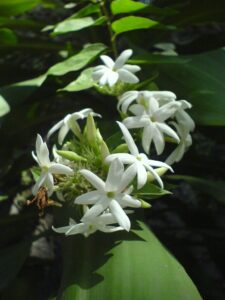
Image Source: Flickr
2. Neem Flowers
The healing nature of neem is no mystery, but did you know that the tender white flowers of this tree also provide antiseptic benefits of its own? They are cooling and purifying in nature, making it a common presence in south Indian cuisine and herbal tonics.
The home gardener warns against overwatering the neem plant. “Apart from that, neem grows best if you grow it in the ground and it thrives well in companionship. If you notice your surroundings, you will see that most neem trees grow in areas surrounded by other plants,” she says.
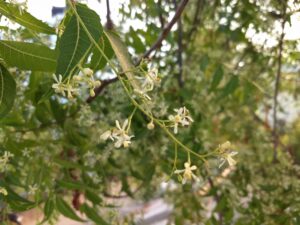
Image Source: Wikimedia Commons
3. Curry Leaf Flowers
While curry leaf is the star ingredient in many flavourful Indian dishes, its flower alone makes for a palatable cup of tea to begin your day with. In her experience, its consumption aids digestive functioning and is soothing for its antioxidant properties.
“Its plant particularly needs sun. It also does best in well drained soil — use enough coco peat or rice husk during its planting. A 4:3:3 ratio of soil, peat and cow dung works the best. If coco peat is not easily available, you can even add timber shavings or shredded jute rope to attain the desired texture of soil,” Punam reveals.
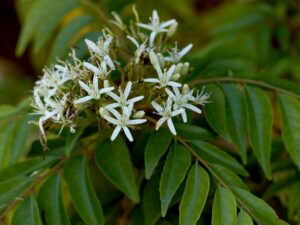
Image Source: Flickr
4. Red Hibiscus
Slightly tart, slightly sweet, the hibiscus flower is a joy ride for your palate — whether consumed directly or infused in teas or salads. It has been proven to relieve menstrual troubles and acts as a relieving coolant on those sultry summer days.
“But it is only the single hibiscus formation that is edible, not the double,” she shares. “It is a hardy plant, and hence great for those looking for something low maintenance. It can grow well in normal garden soil with just a little cow dung added to it for extra nutrients.”
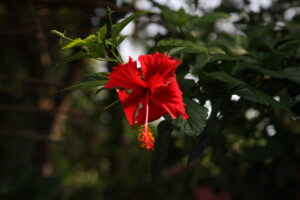
Image Source: Wikimedia Commons
5. Drumstick Flowers
The green lover describes these as “divine flowers shaped like white angels”. They are best consumed when fresh and are a powerhouse of essential vitamins and minerals. One can pound them into a delectable chutney or sip on its juice for a healthy breakfast.
“While moringa (drumstick) is known for its drought-resistant qualities, what most people don’t realise is that it needs daily watering in sufficient amounts during the planting stage. The first two weeks of growing this plant require extreme care to avoid wilting. The best way to grow it if you don’t have a sapling is to use the dry pod and plant half of it in soil, and water it everyday until saplings begin to sprout,” reveals Punam.
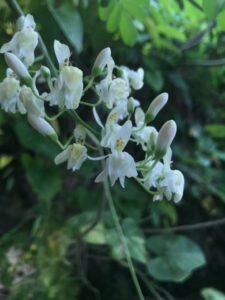
To disperse more of such knowledge, she is currently curating a book on regional herbs, wild edible weeds and other indigenous plants as shared by urban gardeners across the country. You can read her work on her blog.
Edited by Yoshita Rao
If you found our stories insightful, informative, or even just enjoyable, we invite you to consider making a voluntary payment to support the work we do at The Better India. Your contribution helps us continue producing quality content that educates, inspires, and drives positive change.
Choose one of the payment options below for your contribution-
By paying for the stories you value, you directly contribute to sustaining our efforts focused on making a difference in the world. Together, let’s ensure that impactful stories continue to be told and shared, enriching lives and communities alike.
Thank you for your support. Here are some frequently asked questions you might find helpful to know why you are contributing?


This story made me
-
97
-
121
-
89
-
167











